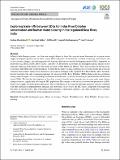Files in this item
Exploring trade-offs between SDGs for Indus River Dolphin conservation and human water security in the regulated Beas River, India
Item metadata
| dc.contributor.author | Momblanch, Andrea | |
| dc.contributor.author | Kelkar, Nachiket | |
| dc.contributor.author | Braulik, Gill | |
| dc.contributor.author | Krishnaswamy, Jagdish | |
| dc.contributor.author | Holman, Ian | |
| dc.date.accessioned | 2022-01-24T16:30:14Z | |
| dc.date.available | 2022-01-24T16:30:14Z | |
| dc.date.issued | 2021-10-11 | |
| dc.identifier | 276251605 | |
| dc.identifier | a63788fc-181a-4e45-a61e-22e9087f234b | |
| dc.identifier | 85116901017 | |
| dc.identifier | 000706070800001 | |
| dc.identifier.citation | Momblanch , A , Kelkar , N , Braulik , G , Krishnaswamy , J & Holman , I 2021 , ' Exploring trade-offs between SDGs for Indus River Dolphin conservation and human water security in the regulated Beas River, India ' , Sustainability Science , vol. Online First . https://doi.org/10.1007/s11625-021-01026-6 | en |
| dc.identifier.issn | 1862-4057 | |
| dc.identifier.other | RIS: urn:206B5C4AAC871E7B3B59B4770882FA63 | |
| dc.identifier.other | ORCID: /0000-0001-8919-4187/work/101581554 | |
| dc.identifier.other | RIS: urn:206B5C4AAC871E7B3B59B4770882FA63 | |
| dc.identifier.other | RIS: Momblanch2021 | |
| dc.identifier.uri | https://hdl.handle.net/10023/24741 | |
| dc.description | This work was supported by the Global Challenges Research Fund through quality-related funding (QR GCRF) and the UK Natural Environment Research Council (Grant number NE/N015541/1). J. Krishnaswamy acknowledges support from the Climate Change and Disaster Risk Mitigation component of the National Mission on Biodiversity and Human Well-being supported by the Office of the Principal Scientific Adviser to the Government of India and Google Research (Google Grant for AI on Social Good). | en |
| dc.description.abstract | In India’s Indo-Gangetic plains, river flows are strongly altered by dams, barrages and water diversions for irrigation, urban supply, hydropower production and flood control. Human demands for freshwater are likely to intensify with climatic and socio-economic changes, exacerbating trade-offs between different sustainable development goals (SDGs) dependent on freshwater (e.g. SDG2, SDG6, SDG7, SDG11 and SDG15). Freshwater ecosystems and endangered aquatic species are not explicitly addressed in the SDGs, but only nested as targets within SDG6 and SDG15. Thus, there is high risk that decisions to advance other SDGs may overlook impacts on them. In this study, we link a water resource systems model and a forecast extinction risk model to analyze how alternative conservation strategies in the regulated Beas River (India) affect the likelihood of survival of the only remaining population of endangered Indus River Dolphins (IRD) in India in the face of climate change-induced impacts on river hydrology and human water demands, explicitly accounting for potential trade-offs between related SDGs. We find that the frequency of low flow released from the main reservoir may increase under some climate change scenarios, significantly affecting the IRD population. The strongest trade-offs exist between the persistence of IRD, urban water supply and hydropower generation. The establishment of ecologically informed reservoir releases combined with IRD population supplementation enhances the probability of survival of the IRD and is compatible with improving the status of relevant SDGs. This will require water managers, conservation scientists, and other stakeholders to continue collaborating to develop holistic water management strategies. | |
| dc.format.extent | 19 | |
| dc.format.extent | 2723048 | |
| dc.language.iso | eng | |
| dc.relation.ispartof | Sustainability Science | en |
| dc.subject | Sustainable development goals | en |
| dc.subject | Dams and barrages | en |
| dc.subject | Punjab | en |
| dc.subject | Floodplain rivers | en |
| dc.subject | Indus Dolphin | en |
| dc.subject | Conservation planning | en |
| dc.subject | GE Environmental Sciences | en |
| dc.subject | TC Hydraulic engineering. Ocean engineering | en |
| dc.subject | TD Environmental technology. Sanitary engineering | en |
| dc.subject | DAS | en |
| dc.subject | SDG 6 - Clean Water and Sanitation | en |
| dc.subject | SDG 13 - Climate Action | en |
| dc.subject | SDG 15 - Life on Land | en |
| dc.subject.lcc | GE | en |
| dc.subject.lcc | TC | en |
| dc.subject.lcc | TD | en |
| dc.title | Exploring trade-offs between SDGs for Indus River Dolphin conservation and human water security in the regulated Beas River, India | en |
| dc.type | Journal article | en |
| dc.contributor.institution | University of St Andrews. School of Biology | en |
| dc.identifier.doi | 10.1007/s11625-021-01026-6 | |
| dc.description.status | Peer reviewed | en |
This item appears in the following Collection(s)
Items in the St Andrews Research Repository are protected by copyright, with all rights reserved, unless otherwise indicated.

